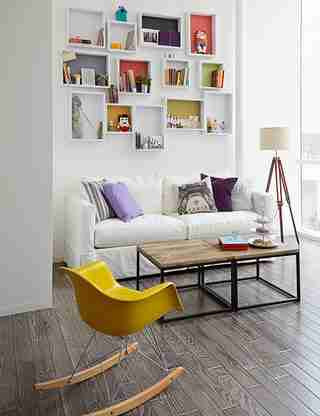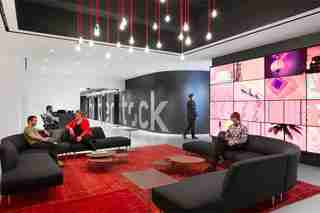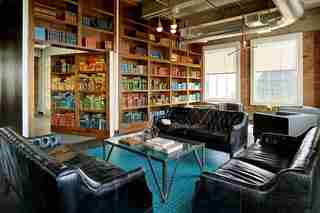
Airbnb, San Francisco
Due to an astronomical boom in the sharing economy, the pioneering home-rental service Airbnb quickly outgrew its two offices. Founders Brian Chesky, Joe Gebbia, and Nathan Blecharczyk enlisted the architecture firm Gensler to devise the company’s new headquarters in the South of Market neighborhood. Completed in 2013, the travel-inspired work space is spread over 72,000 square feet, and while the open-floor layout eschews private offices, there are plenty of unique spots for quiet work or collaboration—including replicas of popular listings in Bali, Reykjavík, Paris (shown), and other far-flung locales, created by Kassin Laverty of the firm IDF.

Shutterstock, Manhattan
The online image-licensing company called on Studios Architecture to create its new midtown headquarters on the 20th and 21st floors of the Empire State Building. While the location is historic, the 80,000-square-foot loftlike space is filled with modern amenities, including a steampunk-style secret library, game areas, a café, a yoga studio, and massage rooms. The floors are connected by a 10-foot-wide staircase (the broadest in the building) enclosed with an eye-catching Art Deco–inspired metal screen.

Lumosity, San Francisco
Lumosity specializes in brain-training games, so it’s only natural that its office is visually stimulating. Located in a historic Art Deco building, the company’s 38,000-square-foot loftlike headquarters was devised by Lauren Geremia of Geremia Design (one of* AD*’s 2013 “Ones to Watch”) with Boor Bridges Architecture. There are lots of spaces for collaboration and socializing, including a game room, a fully stocked bar, a cafeteria, and a library (shown) that’s accessed through a hidden door. Geremia custom designed furniture for the café and conference rooms, and works by artists from the Creative Growth Art Center, a local organization that helps developmentally disabled adults, are displayed throughout the space.
Pandora, Oakland, California
Music is everywhere at the headquarters of the Internet radio company Pandora, located just across the East Bay from San Francisco. Studios Architecture worked on the expansion of the now 100,000-square-foot office, which houses nearly 800 employees. The break area includes custom booths forming the word radio (shown) , and recording-studio-inspired meeting rooms that reference Simon and Garfunkel’s “Scarborough Fair,” among other moments in music history. In addition to the standard tech-world perks like unlimited drinks and snacks, there’s also a vending machine that dispenses headphones and other gadgets to keep. And of course, there are plenty of in-office concerts.
Pinterest, San Francisco
To fit with the mission of the online curation site, Pinterest wanted a headquarters that its employees could help personalize. A bicoastal team—composed of New York’s All of the Above, Los Angeles’s First Office, and local firm Schwartz and Architecture—created the industrial, yet modern facility. White volumes were inserted into the former warehouse space to construct conference areas, and a large central atrium was lined with long tables for dining and meeting. Since the company arrived in 2013, employees have customized the office, from turning blank surfaces into makeshift whiteboards to designing a speakeasy-style bar in a leftover space.
Kickstarter, Brooklyn
In 2014 the crowd-funding site moved its headquarters from a Lower East Side tenement building to a converted pencil factory in Brooklyn’s Greenpoint neighborhood. Architect Ole Sondresen transformed the abandoned building using reclaimed materials, among them recycled-denim insulation. The light-filled 29,000-square-foot space is situated around a central courtyard and includes a gallery, a 74-seat theater, a library (shown), a cafeteria, and a green roof boasting a staff-tended garden that provides the office with healthy snacks.
Yelp, San Francisco
While some companies opt for sprawling campuses, the crowd-sourced reviews site Yelp worked with Studio O+A to develop a vertical campus encompassing 13 floors of a historic Financial District high-rise. Amenities such as a coffee bar with handwoven light fixtures and a general store–themed reception area are located on different floors to encourage mingling. Exposed brick and reclaimed wood bring out the character of the 1925 building, which was designed by noted San Francisco architect Timothy Pflueger for the Pacific Telephone and Telegraph Company.
GitHub, San Francisco
GitHub’s goal is to make it easier to collaborate on software development, and its South of Market headquarters brings this idea to life. Studio Hatch and Fennie + Mehl worked with the company to plan a space with flexible work environments that could evolve over time as the team grew. The three-story, 60,000-square-foot office, located in a former dried-fruit warehouse, includes a café on each floor, conference rooms with themes (such as Rat Pack, saloon, and safari), a dojo, a speakeasy, and a roof deck. But without a doubt its most distinguishing feature is the reception room—an exact replica of the White House’s Oval Office.
Square, San Francisco
The architecture firm Bohlin Cywinski Jackson was inspired by urban planning when designing the Mid-Market headquarters of the mobile-payment company Square. On the main floor, a “boulevard” provides access to a variety of communal work spaces, a library, a conference room, and a coffee bar (which acts as a testing ground for the latest versions of the payment system). Eucalyptus and white oak are used throughout, making the space, which is the length of a city block, feel warm and intimate.
Uber, San Francisco
Studio O+A masterminded the slick design of the car-service app Uber’s headquarters in the Mid-Market neighborhood. The materials used are a reflection of the company’s different service tiers, with concrete and raw steel representing its standard UberX offering and copper, oxidized maple, and onyx glass (a nod to tinted limousine windows) embodying its more upscale Uber Black option. A quarter-mile track curves through the 90,000-square-foot space for Sorkin-esque walk-and-talks, and a “war room” features glass walls that turn opaque with the touch of a button.
